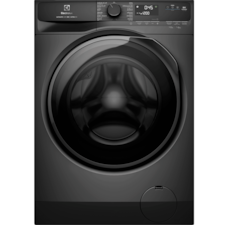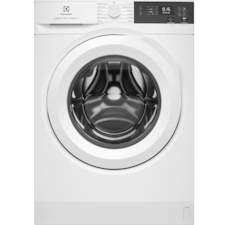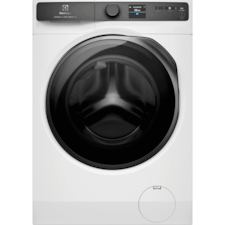Load capacity, size, and types are key things to consider while choosing a washing machine but what else? Explore our comprehensive selection guide to gain invaluable insights into what to prioritize before making a purchase.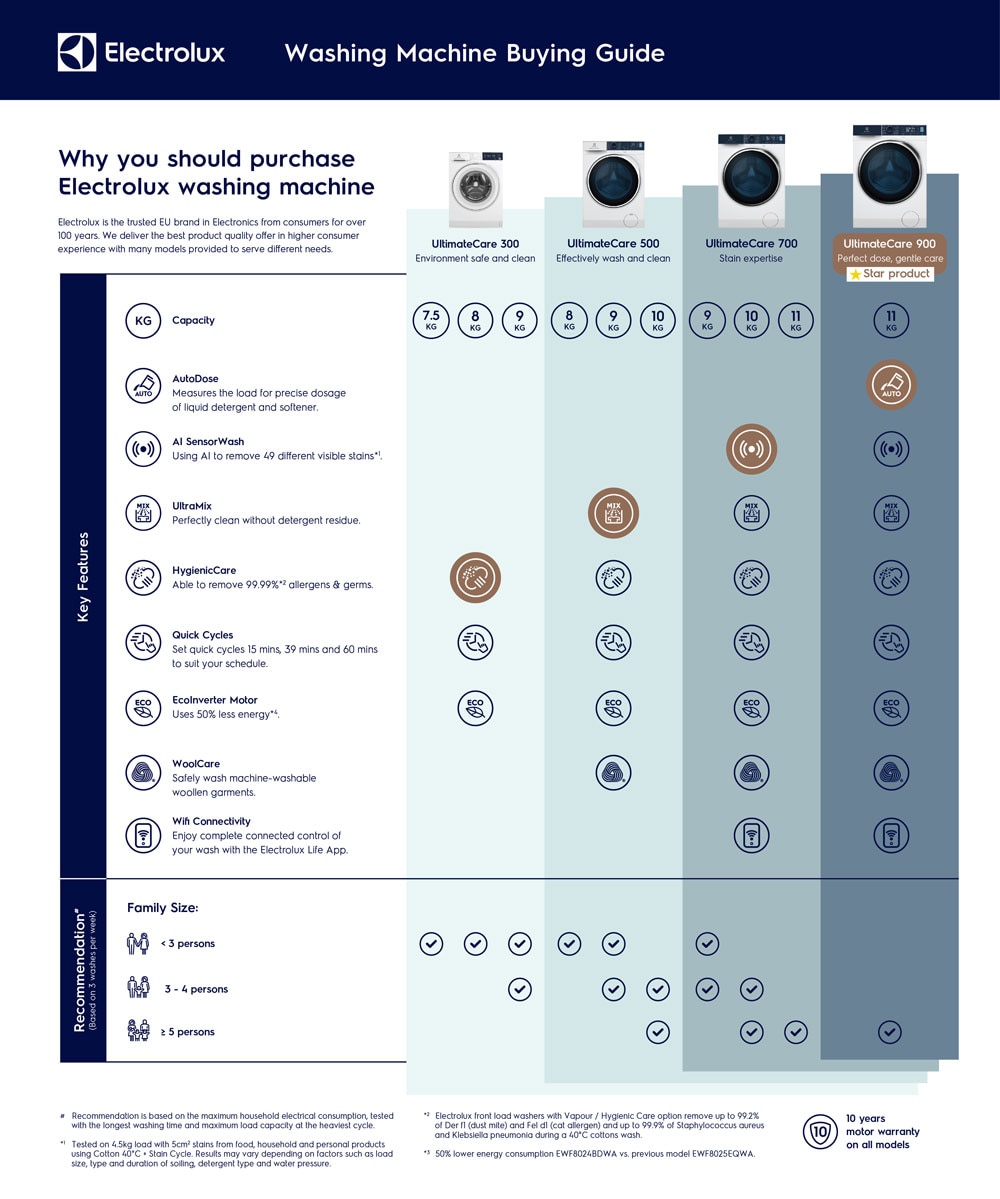
1. Tips on choosing washing machine capacity
What does washing machine capacity mean?
When it comes to how to choose a good and durable washing machine, understanding the concept of washing capacity and how it is determined is crucial.
The washing capacity of a washer simply refers to the maximum amount of clothes in kg can be washed in one cycle. The washing capacity is always measured by the weight of the dry laundry. For example, a 8kg washing machine means it can load up to 8kg of dry clothes in each cycle.
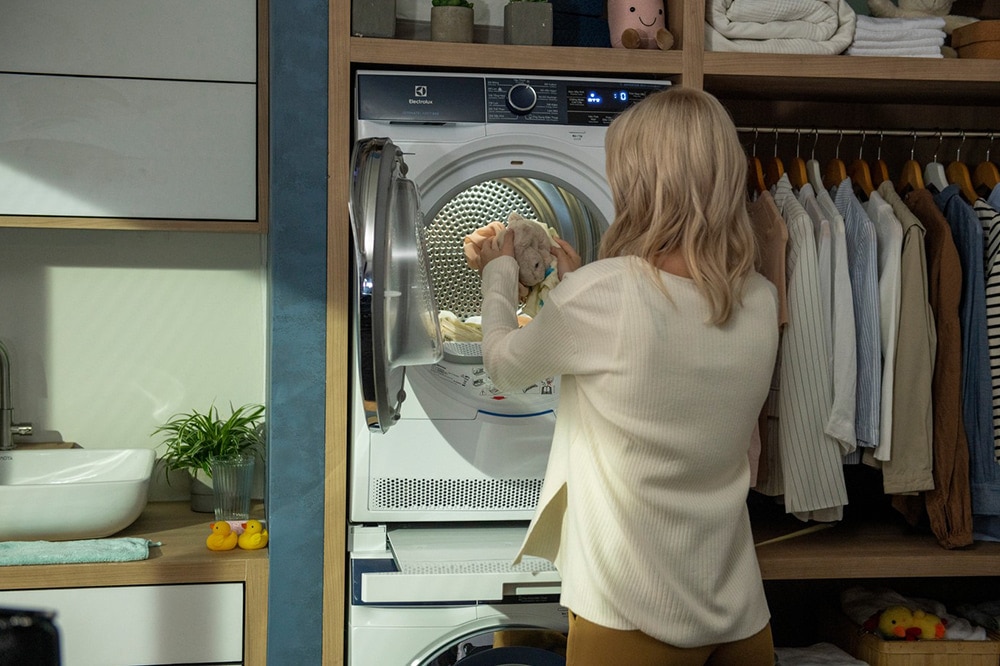
How to choose washing machine capacity by family size
Now that you have an idea of what washing capacity is, here is a brief guide on how to find out how many kg of a washing machine you will need according to family size:
| Washing machine capacity (kg) | Family size |
| 6-7kg washing machines | Singles or couples |
| 7-8kg washing machines | 2-3 members |
| 8-9kg washing machines | 3-5 members |
| 10+ kg washing machines | 5+ members |
While this capacity guide is easy to follow, you may find yourself wondering, "What if I have a small family of two, but we typically have heavy-duty loads for each cycle?" Let's explore our solution in the upcoming section.
How to choose washing machine capacity by average laundry load
Another effective way in determining the appropriate washing capacity of the washer for your home is to weigh the average load of clothes you usually wash in each cycle. This might sound obscure to some, yet it’s practical in helping you select a washing machine with a suitable load capacity.
Traditionally, it is recommended to opt for the minimum washing capacity for your needs. However, as most of modern washing machines come with intelligent sensor technology that adjusts water levels, you can confidently opt for a higher capacity without having to sacrifice efficiency.
2. Washing machine load capacity
Now that you know how to choose the right washer based on washing capacity, it’s time to talk about load capacity or load size. Load capacity is basically about how many pieces of clothes you can put in your washing machine in each cycle.
Here is a brief guideline on washing machine capacity and the corresponding number of clothes it can load for your reference:
| Washing machine capacity | How many clothes |
| 6-7kg washing machines | 20 clothes |
| 7-8kg washing machines | 30-35 clothes |
| 8-9kg washing machines | 40 clothes |
| 10+ kg washing machines | 50 clothes |
To give you a more itemized idea, here is a breakdown of what various load sizes might look like:
| Load capacity | How it might look like |
| 20 clothes | 2 shirts, 2 trousers, 2 bath towels, 2 hand towels, 2 pillow covers, 1 large bedsheet |
| 30-35 clothes | 2 shirts, 2 pairs of denims, 2 pairs of children’s jeans, 2 bath towels, 2 pillow covers, 2 bedsheets |
| 40 clothes | 3 shirts, 3 pairs of adult denims, 3 small towels, 3 pillow covers, 3 bath towels, 2 bedsheets |
| 50 clothes | 4 shirts, 4 pairs of adult denims, 4 small towels, 4 bath towels, 4 pillow covers, 3 bedsheets |
3. Washing machine size guide (dimensions)
Besides washing capacity and load capacity, you must also consider the size of the washing machine. The washing machine you choose must accurately fit within the allocated space.
To select the ideal washing machine for your home, be sure to follow these steps:
- Measure the space where you intend to place the washer.
- Take note of the dimensions.
- Choose a washer that fits within that space.
Here’s a washing machine size chart showing common dimension ranges of a normal washing machine:
| Washing machine type | Width |
| Top load washing machine | 540 to 600 mm |
| Front load washing machine | 565 to 600 mm |
| Small washing machine | 385 to 430 mm |
Important notes:
- Remember to leave a gap of approximately 25 mm on both sides of the washing machine. This extra space facilitates proper ventilation and minimizes overheating and vibration.
- Allocate an additional 150 mm of space behind the washer for hoses and venting purposes.
- Allow for at least 500 mm of extra depth for front-loading washers or height for top-loading washers to ensure there is enough space when the lid is open.
4. Types of washing machines
In the previous section, we mentioned the common size ranges of washing machines. However, it is also important to consider the different types of washing machines and determine which type best suits your needs. Here is a guide to help you understand the various available options.
Washing machines are typically categorized into two types based on where your clothes are loaded:
Top load washing machines
Top load washing machines are designed with a door on the top of the machine. This layout offers the convenience of loading clothes from above, eliminating the need to bend over while doing laundry. Especially, you are free to add or remove items in the middle of the washing cycle.
Front load washing machine
Unlike top load washers, front loaders come with a door at the front, allowing for a horizontal drum loading experience. This design is common in many regions of the world, especially for high-end washers and are preferred choice for commercial and industrial laundry machines.
Compared to top loaders, front loaders are equipped with more advanced features such as a function to pre-soak and distribute laundry items evenly, a sensor technology to automatically adjust water levels based on actual washing load, and an advanced child lock.
Read more: Front load vs top load washing machines
5. Set your budget
Many people believe that choosing a basic top-load washing machine is a suitable option for those constrained by budgetary considerations. This perception holds some truth, given that top loaders often come with affordable price tags and sufficient features to fulfil their purpose.
In contrast, front loaders generally have higher upfront costs. However, the initial investment in a front load washing machine can quickly be offset by long-term savings due to their superior energy and water efficiency.
Choose a good and durable front load washing machine from our best-selling Electrolux front loaders:
-
- Prevents visible detergent residue with UltraMix.*
- Efficient full-load washing in only 45 mins.
- Sanitise removes 99.99% common bacteria & viruses.*
-
- Added hygiene and gentle care.
- Efficient full-load washing in only 45 mins.
- Sanitise removes 99.99% common bacteria & viruses.*
-
- Added hygiene and gentle care.
- Efficient full-load washing in only 45 mins.
- Sanitise removes 99.99% common bacteria & viruses.*
6. Spin speed or RPM (rounds per minute)
If you are wondering which RPM is good for each type of washing machine, here is a brief rule of thumb:
- For front load washing machines, anything above 1000 RPM is considered good.
- For top load washing machines, anything above 850 RPM is considered good.
Below is a table that provides a breakdown of the ideal operating RPM for different types of fabric:
| Front load washing machine | Top load washing machine | |
| Frail clothes | 400 – 600 RPM | 300 – 400 RPM |
| Wool items | 700 – 900 RPM | 400 – 500 RPM |
| Synthetic items | 800 – 1000 RPM | 500 – 600 RPM |
| Jeans & thick items | 900 – 1200 RPM | 600 – 1000 RPM |
Related posts:
7. Energy efficiency index (EEI)
It's important to select a washing machine that consumes less power and water as this will result in long-term cost savings.
Since 2010, a new EU energy rating system has been introduced which utilises the energy efficiency index (EEI) to classify washing machines. The ratings range from A-30% (or A+++) to D, with A-30% representing the highest efficiency and D being the least efficient. It is advisable to purchase a washing machine with an EEI of at least A-10% (or A+) to ensure optimal energy efficiency. 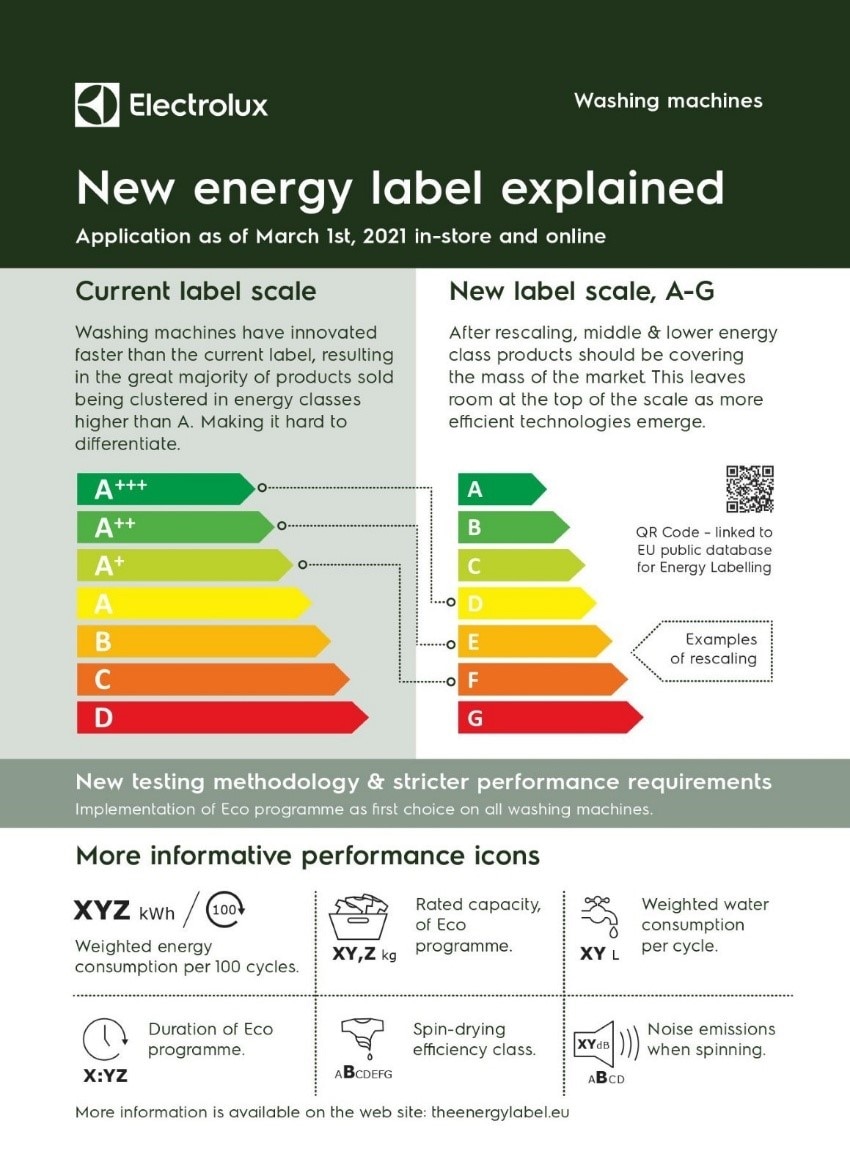
Good news: All Electrolux washing machines are energy efficient, boasting ratings of A-30% and higher. For example, some Electrolux energy efficient washing machines are even rated at an impressive A-50% in terms of energy efficiency.
8. Washing machine technologies to look for
The latest washing machine technologies are designed to provide optimal cleaning performance and make your life easier. If your top priorities are maximum convenience and achieving the best possible clean, here are some key features to look for when buying a washing machine:
- Delicate care program: This is a specialised program to protect your treasured garments, using a reverse cradle action, for a reduced wrinkle wash.
- Automatic mixing of detergent and softener: This function is designed to protect every fibre by optimally blending water, detergent, and softener before entering the drum, conserving the life of your clothes. Related reading: Liquid vs. powder detergent vs. pods: Which is best to use?
- Automatically-tailored washing programme: This feature automatically optimises the programme for the actual laundry load to save resources and avoid over washing. Smart sensors save the time, water and energy used, while ensuring even small loads are washed with precision.
- Self-cleaning feature: Self-clean function helps to maintain the performance of your washing machine if run on a regular basis. For more manual cleaning tips, read our complete guide on how to clean a washing machine.
- Connectivity: A smart laundry is only one push away with the Electrolux Life App. Connect your laundry appliances to your phone for convenient customised care.
9. Consult reviews and ratings
One of the most valuable tools for assessing a washing machine, or any other products, is unbiased, first-hand accounts from other customers, allowing you to gauge its performance, strengths, and authenticity of claims.
Seek out in-depth reviews, including articles and videos, that thoroughly evaluate each aspect of the washing machine.
10. Washing machine FAQs
-
What size washing machine do I need?
- For singles or couples: 6–7 kg.
- For small families: 7–8 kg.
- For large families: 8+ kg.
-
Which is better: top loading or front loading washing machine?
The best washing machine for you will depend on your laundry habits, the amount of laundry, space constraints, and budget. For energy and water efficiency coupled with superior cleaning, a front-loading washer might be best. For budget constraints and simpler operation, a top-loading model might be suitable.
-
What is the best spin speed for a washing machine?
The best spin speed for a washing machine depends on the type of fabrics you're washing and the desired dampness of the clothes at the end of the wash cycle. Use higher speeds (1200-1400 RPM) for heavier items to reduce drying time, and lower speeds (600-800 RPM) for delicate items to prevent damage.
-
What is inverter technology in washing machines?
Inverter technology adjusts motor speed based on load size, saving energy and enhancing performance.
-
How many clothes can be put in a 7kg washing machine?
A 6kg or 7kg washing machine can fit up to 20 clothing items.
-
How many clothes can be put in a 8kg washing machine?
An 8kg washing machine can fit up to 35 clothing items.
-
How many clothes can be put in a 9kg washing machine?
A 9kg washing machine can fit up to 40 clothing items.
-
How many clothes can be put in a 10kg washing machine?
A 10kg washing machine can fit up to 50 clothing items.

